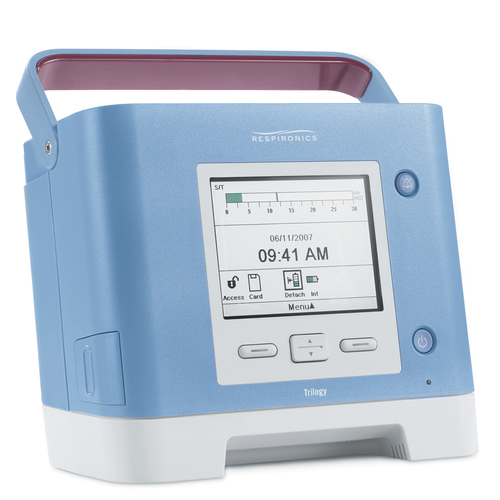Trilogy Ventilator
Trilogy Ventilator
From Respironics | Item #TRILOGY
FeaturesLeak compensationThe Trilogy 202 has the unique ability to compensate for leaks in both pressure and volume control modes. This allows the use of simpler passive circuits,...
- In Stock
Details & Specs for Trilogy Ventilator
Features
Leak compensation
The Trilogy 202 has the unique ability to compensate for leaks in both pressure and volume control modes. This allows the use of simpler passive circuits, which may save time and reduce costs. With one simple setting change, the Trilogy 202 supports either active or passive exhalation breathing circuits to accommodate changes in circuit preference.
Portable design for intra-hospital transport
The Trilogy 202 allows freedom of movement. With a 3-hour internal battery and optional 3-hour detachable battery, you’ll have sufficient power for intra-hospital transports – with plenty of time for any delays or detours. It weighs only 5.6 kg and has an integrated carrying handle for convenient handling during intra-hospital transports.
Auto-Trak improves synchrony
The Auto-Trak algorithm improves patient-ventilator synchrony by adjusting to changing breathing patterns and dynamic leaks. The auto-adaptive triggering, cycling, and leak adjustments may help reduce the time clinicians spend adjusting thresholds and re-fitting masks.
Uniform settings to support hospital to home transition
Besides sharing a common user interface, all home and hospital Trilogy ventilators offer identical ventilation modes and breathing circuit settings. Home-bound patients receive the same finely tuned ventilatory support they received in the hospital. Stored data can be downloaded for review and evaluated to identify trends.
Leak compensated volume modes to improve consistency
Trilogy 202 offers all the conventional volume-control modes: AC, SIMV (with or without PS), and CV. The Trilogy 202 is designed to compensate for leaks in a volume control mode. This means consistent tidal volume delivery even during noninvasive or when cuff leaks are present.
Specifications
Controls IPAP 50 cm H₂O
CPAP 4 - 20 cmH20 (passive leak port circuits) cm H₂O
EPAP/PEEP (a) 0 - 25 cmH20 (active valve circuits) cm H₂O
EPAP/PEEP (b) 4 - 25 cmH20 (passive leak port circuits) cm H₂O
Pressure support 0 – 30 cmH2O cm H₂O
Tidal volume 50 - 2000 ml
Breath rate(a) 0 - 60 BPM (AC mode) beats per minute
Breath rate(b) 1 - 60 BPM (all other modes) beats per minute
Inspiratory time 0.3 - 5.0 s Synchrony features
Rise time 1 - 6 (relative scale)
Ramp start pressure (a) 0 - 25 cmH20 (active circuits) cm H₂O
Ramp start pressure (b) 4 - 25 cmH20 (passive circuits) cm H₂O
Ramp start pressure (c) 4 - 19 cmH20 (CPAP mode) cm H₂O
Ramp time 5 - 45 min
C-Flex 1 - 3 (relative scale)
Flow trigger sensitivity 1 - 9 l/min
Flow cycle sensitivity 10 - 90 %
Environmental - IntelliBridge EC40/80 Operating temperature 5 – 40 °C
Relative humidity 15 - 95 %
Storage temperature -20 – 60 °C
Atmospheric pressure 60 - 110 kPa (450 - 825 mmHg)
Patient types Adult Yes
Pediatric ≥ 5 kg or greater
Electrical - IntelliBridge EC40/80 Input voltage 100 - 240 VAC and 50/60 Hz and 2.1 A
Detachable battery voltage 14.4 VDC
Internal battery life 3 hours under normal conditions hr
Detachable battery life 3 hours under normal conditions hr
external battery connection 12 VDC
Volume modes Pressure control (PC) Yes
MPV Mouthpiece Ventilation Mode Yes
Synchronized intermittent mandatory ventilation (SIMV) Yes
SIMV with pressure support (SIMV w/PS) Yes
Control ventilation (CV) Yes
Alarms Low tidal volume 50 - 2000 ml
Circuit disconnect 10 - 60 sec
Apnea 10 - 60 s and 4 - 60 BPM
High tidal volume 50 - 2000 ml
High minute ventilation 1 - 99 l/min Off, 1 - 99 l/min
Low minute ventilation 1 - 99 l/min
High respiratory rate 4 - 80 beats per minute
Low respiratory rate 4 - 80 beats per minute
Pressure modes Pressure control (PC) Yes
Pressure control-SIMV (PC-SIMV) Yes
Spontaneous ventilation (S) Yes
Spontaneous ventilation with timed back-up (S/T) Yes
Timed ventilation (T) Yes
Continuous positive airway pressure (CPAP) Yes
Average volume assured pressure support (AVAPS) With passive circuit type, S, S/T, PC, and T modes only
Options Detachable back-up battery Offering up to 3 hours additional operating time
Hospital roll stand Provides convenient accessory basket and humidifier mount
DirectView 1 GB SD card data storage integrated into the ventilator software
Monitored parameters Tidal volume 0 - 2000 ml
Minute ventilation 0 - 99 l/min
Estimated leak rate 0 - 200 l/min
Respiratory rate 0 - 80 beats per minute
Peak inspiratory flow 0 - 200 l/min
Peak inspiratory pressure 0 - 99 cm H₂O
Mean airway pressure 0 - 99 cm H₂O
% patient triggered breaths 0 - 100 %
I:E ratio 9.9:1 - 1:9.9
Synchrony features Auto-Trak sensitivity Auto-Trak sensitivity Auto-adaptive triggering, cycling, and leak compensation (available in all modes, passive circuit only)
Adjustable flow triggering 1 – 9 l/min (available in all modes and circuit types) l/min
Circuit types Active exhalation valve with proximal airway pressure (PAP) Yes
Active exhalation valve with flow sensor Yes
Passive exhalation port Yes
Compliance IEC 60601-1-2 General requirements for safety – collateral standard Electromagnetic compatibility – requirements and tests Yes
IEC 60601-1 Medical electrical equipment Part 1: General requirements for safety Yes
IEC 60601-2-12 Medical electrical equipment Part 2-12: Particular requirements for the safety of lung ventilators – Critical Care ventilators Yes
Oxygen FiO2 21 - 100 %
02 flush 2 min at 100%
02 input pressure range 276 - 600 kPa (40 - 87 psi)



